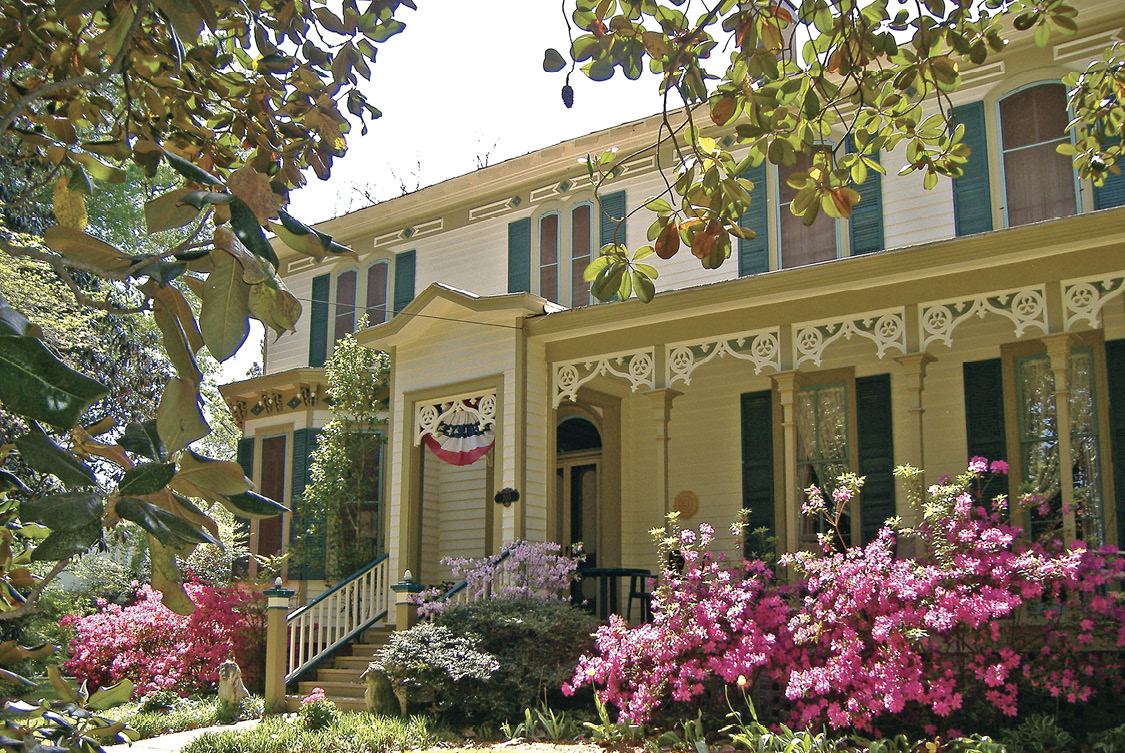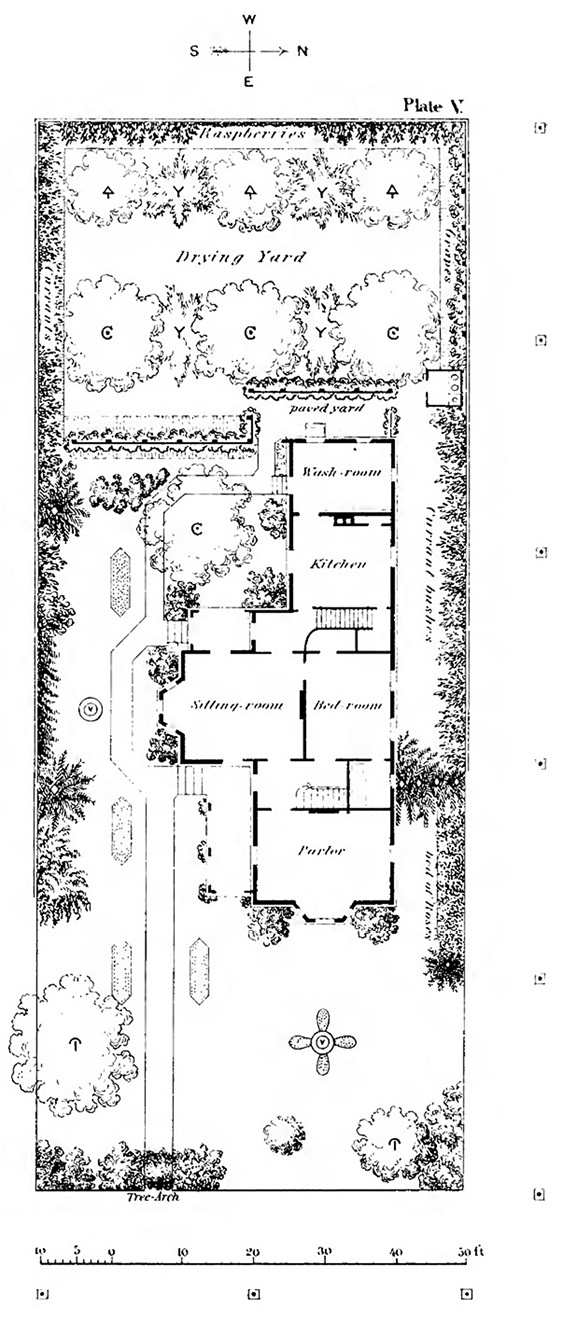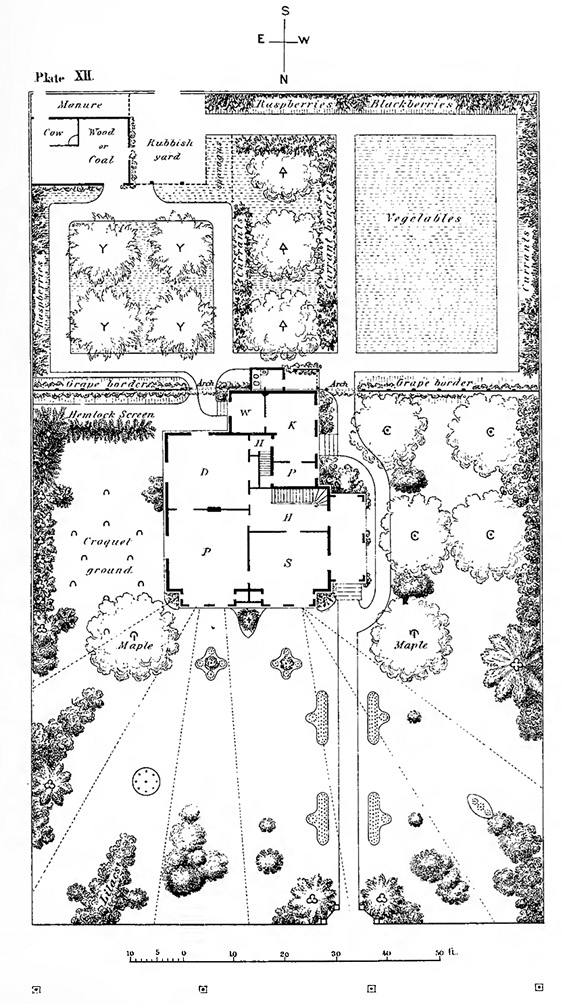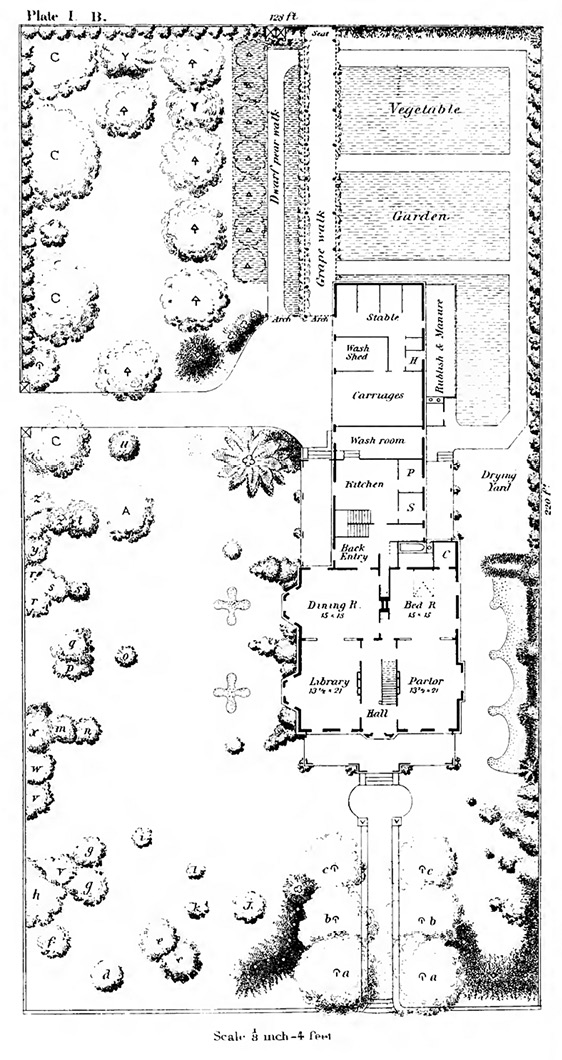Landscape Design for Homes of the Late Victorian Era (1860-1900)

Beautiful Victorian-era homes are prevalent throughout the South. In Mississippi, examples can be found in most small towns with plentiful examples in Natchez, Aberdeen, Columbus, Oxford, and Holly Springs. While they are not what most people think of when they imagine old Southern homes, these homes are a vital and often overlooked part of our region’s history.
Landscaping a Victorian-era property can be challenging. Unlike antebellum plantation homes, these residences were usually built in urban locations where property has been in heavy demand. For this reason, many Victorian homes have been adapted for other uses or had their properties subdivided. Further complicating matters, the landscape of such properties has often changed drastically over the years, making it quite difficult to determine the character or features of the original landscape. But with some research, determination, and effort, the owner of a Victorian residence can create a useful and appropriate landscape to complement the home’s dynamic architecture.
Background
Landscapes are never created in a vacuum. Conditions in the South during the late 1800s were influential in shaping the home landscapes and ornamental gardens that were created during this period. Many properties were built after Reconstruction during the industrial boom that occurred from 1870 to 1900.
As industrialists, doctors, lawyers, and successful merchants became wealthy, they built large, impressive homes in many Southern communities. These homes were symbols of status and usually located in prominent positions in town along major thoroughfares. They included large porches, rich wood detailing, and a variety of paint colors, thereby presenting a pleasant and intricate façade to the public.
Collections of such homes made for a dramatic display of a town’s wealth and can be seen in locations like the Silk Stocking Row Historic District in Aberdeen. The landscapes that surrounded these homes provided a setting for the dramatic architecture and were sometimes equally ornamental in character.
The late 1800s was a dynamic period in garden history as a result of increased wealth, improved leisure time, and wider availability of products and services. As local grocers, dry goods stores, and meat markets could be relied upon for more and more necessities, home gardeners were able to concentrate increased effort toward ornamental gardening.
More homeowners than ever before embraced gardening as a hobby, and these gardeners had a wider plant palette to experiment with as a result of new introductions from expeditions to places like China and Japan. Gardeners embraced the new exotic plant imports, favoring new evergreens and bold and intricate foliage plants.
While not many homeowners could afford to maintain the detailed carpet bedding that defined Victorian landscapes, simple, layered beds (short on the exterior and taller on the interior) of low-maintenance plants can sometimes been seen in historic photographs from the period.
Primary attention was given to the ornamental street-side garden that passersby could enjoy as much as the homeowners. Ornamental picket fences of wood or cast iron consistently surrounded these gardens. Fences were critical for protecting ornamental plantings from wildlife, wandering livestock, and wayward carriages, but they also helped to establish the property boundary and present a pleasant decorative aspect to the public. Low, clipped evergreen hedges sometimes backed these fences, providing a dramatic backdrop, especially when placed behind white pickets.
Authors from the period, such as Frank J. Scott, who wrote The Art of Beautifying Suburban Home Grounds of Small Extent 1870, advocated for the use of lawns and openness (see Figures 2–4 for examples of plans from Scott’s text). Some Southern gardeners followed this advice, particularly later in the period at large, prominent homes with owners who could afford to maintain large lawns. These turf areas were considered luxurious and a sign of wealth, but they were somewhat less manicured than we might expect today.



Older and more modest properties sometimes had small areas of turf. Other homeowners simply chose heavier plantings with more shade trees. Some homeowners opted for areas of swept yard and had no turf at all.
Despite their reputation for ornamentation, landscapes of the late Victorian era were also places of considerable labor. These work areas were typically located out of view behind the home, as they would be considered unsightly. Many tasks necessary for the upkeep of the household took place in the very private area directly behind the home—food preparation, retrieving water, washing clothes, candle making, and other chores.
The remainder of the rear yard may have contained domestic animals, orchards, and vegetable and herb gardens, as well as associated outbuildings such as stables, hen houses, hothouses, sheds, and carriage houses. However, the size and extent of these areas was considerably diminished from the early and middle part of the 19th century, when homeowners were necessarily self-reliant. In the late 1800s, the home landscape was in a period of transition—not yet completely ornamental in nature (except in rare cases) but definitely moving in that direction.
Garden Design Approach
It can be challenging to decide how best to approach the landscape for a historic home due to the drastic changes that have occurred over time. Property that originally had open views and lawn could now have major specimen trees blocking views to the home and shading out the turf. On one hand, these changes may give the landscape a character that is completely unlike the original design. On the other hand, they provide the feeling of time and age that make such properties so compelling.
A balanced approach is necessary in most cases. This publication offers some general guidance and information for properties from this era. Obviously, every case is unique, and it is advisable to work with a licensed landscape architect to deal with more complicated or significant cases.
Historical Documents
A variety of useful resources can provide information about the history of the home and landscape. The local library is a great place to start and may be helpful in determining the date of construction, prior owners, and original lot information. The local tax assessor’s office may have pertinent property records, and the Mississippi Department of Archives and History could have relevant historic photographs, maps, or other written documentation. University libraries are another possible source of documents and may also have access to the Sanborn Fire Insurance Maps, which can be useful in understanding the original lot layout, outbuildings, and organization.
Before undertaking any landscape alterations, it’s important to have a clear understanding of the home and landscape’s historical significance (whether local, regional, or national). Each individual historic property requires site-specific, thoughtful treatment; sites of significance also require the research skills and expertise of an experienced landscape historian.
General Organization
As can be seen in the Scott examples, considerable emphasis was placed upon the ornamental street-side garden. This landscape created an impressive and inviting setting for the home and demonstrated the family’s wealth and contemporary taste.
For most properties from this period, a contrast between this ornamental landscape and the more service-oriented landscape behind the home is appropriate. These two, distinct areas were often segregated by a visual screen. This could be an opaque wood fence or a landscaped boundary like an evergreen hedge, but the division is clear on many photographs from this period and on the Scott plans in the figures.
Heirloom Plants, Urns, and Vines
Gardeners of this period loved to experiment with dramatic foliage plants and often used potted plants, decorative urns, and hanging plants to create a dynamic porch and garden. Victorian gardeners also made frequent use of vines to create shade and privacy and sometimes even grew vines directly on the structure.
Appropriate plant choices are important; there are many old Southern favorites to choose from, although some caution is warranted as some plants from the era have proven to be invasive (such as English Ivy—Hedera helix). In most cases, however, these plants are showy and easy to grow and useful in establishing an appropriate landscape character for a Victorian home.
|
Common Name |
Scientific Name |
Landscape Value |
|---|---|---|
|
Trees |
||
|
Cedar |
Juniperus virginiana |
Evergreen tree sometimes seen pruned into an archway entry feature |
|
Crape Myrtle |
Lagerstroemia indica |
Small deciduous tree |
|
Cypress Tree |
Taxodium distichum |
Native deciduous tree |
|
Southern Magnolia |
Magnolia grandiflora |
Large, showy, evergreen native tree |
|
Shrubs |
||
|
Arborvitae |
Platycladus orientalis |
Evergreen tree/shrub with bright-green foliage and distinctive form |
|
Banana Shrub |
Michelia figo |
Large, evergreen shrub with small, banana-scented flowers |
|
Boxwood |
Buxus sempervirens |
Evergreen hedge, sometimes planted as a backdrop to a white picket fence |
|
Loquat |
Eriobotrya japonica |
Larger evergreen shrub/tree prized for its fruit |
|
Oleander |
Nerium oleander |
Flowering evergreen shrub |
|
Sweet Olive |
Osmanthus fragrans |
Large evergreen shrub with sweet-smelling blooms |
|
Sweet shrub |
Calycanthus floridus |
Native, deciduous shrub with sweet smelling flowers |
|
Accent Plants |
||
|
Banana Tree |
Musa spp. |
Bold seasonal foliage plant; not cold hardy |
|
Cannas |
Canna indica |
Bold-leaved, flowering accent plant |
|
Cast Iron Plant |
Aspidistra elatior |
Bold foliage plant for shade; frequently used in pots |
|
Century Plant |
Agave spp. |
Dramatic, easy-care potted plant |
|
Daffodils |
Narcissus spp. |
Flowering bulb |
|
Vines |
||
|
Climbing Roses |
Rosa spp. |
Vine grown on porches or arbors |
|
Confederate Jasmine |
Trachelospermum jasminoides |
Evergreen flowering vine with scented white flowers |
|
Coral Honeysuckle |
Lonicera sempervirens |
Native, flowering vine |
Related Mississippi Museums Open to the Public
Manship House Museum (Built in 1857) in Jackson, Mississippi
The Oaks House Museum (Build in 1853) in Jackson, Mississippi
References
Parsons, Samuel, Jr. 1899; reprint 1907. How to Plan the Home Grounds. New York: Doubleday, Page & Co.
Schlereth, Thomas J. 1991. Victorian America: Transformation in Everyday Life 1876–1915. New York: Harper Collins.
Scott, Frank J. 1870. The Art of Beautifying Suburban Home Grounds of Small Extent. New York: D. Appleton & Co.
Weidenmann, Jacob. 1870; facsimile reproduction of Beautifying Country Homes, 1978. Victorian Landscape Gardening, Watkins Glen, N.Y.: The American Life Foundation for the Athenaeum Library of Nineteenth Century America.
Photograph Collections
E. Von Seutter Photograph Collection. Mississippi Department of Archives and History.
The information given here is for educational purposes only. References to commercial products, trade names, or suppliers are made with the understanding that no endorsement is implied and that no discrimination against other products or suppliers is intended.
Publication 2992 (POD-08-22)
Reviewed by Robert Brzuszek, Professor, Landscape Architecture.
The Mississippi State University Extension Service is working to ensure all web content is accessible to all users. If you need assistance accessing any of our content, please email the webteam or call 662-325-2262.

